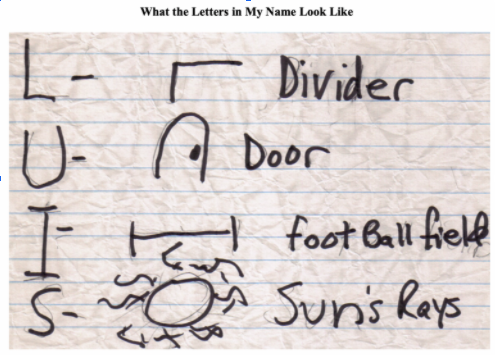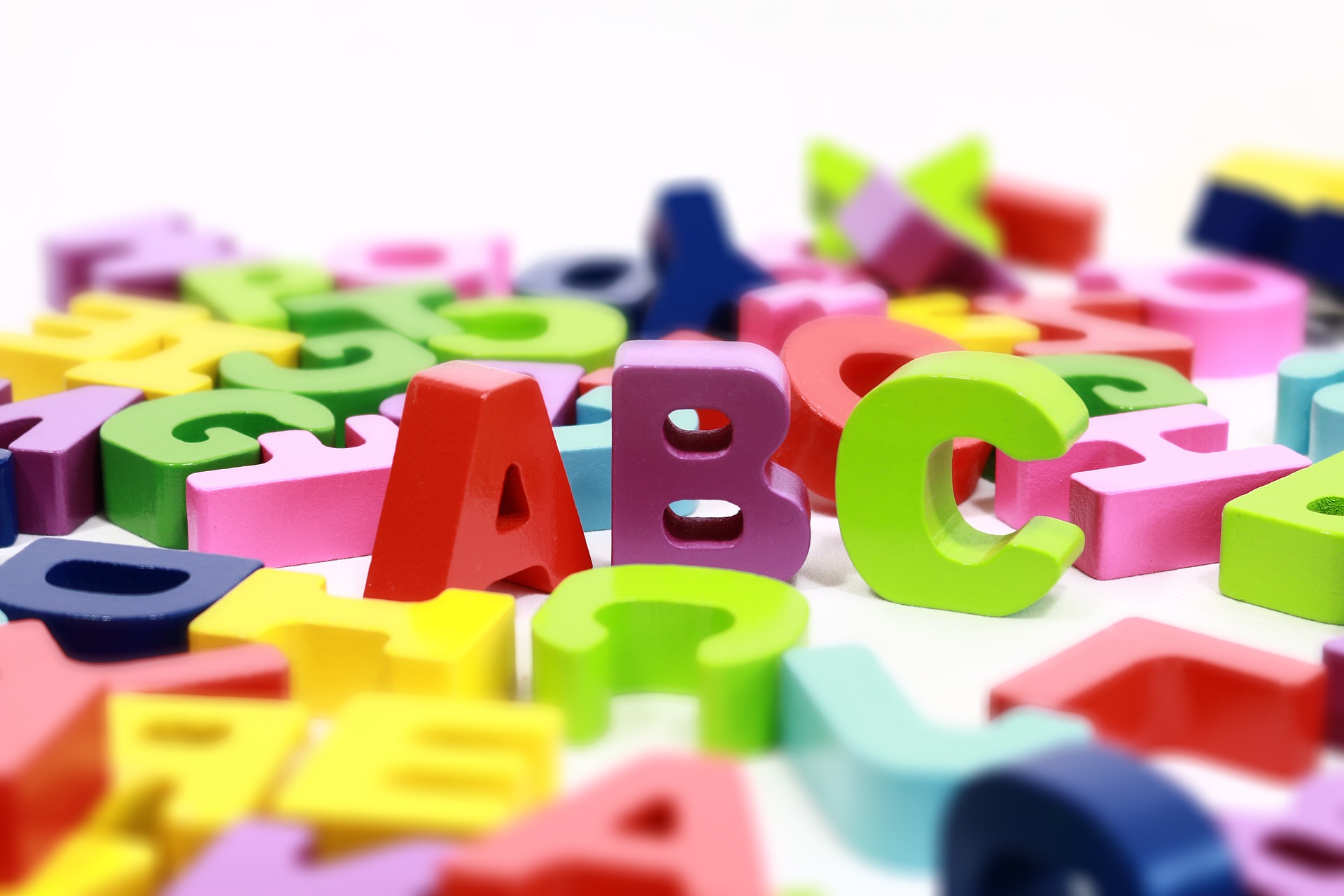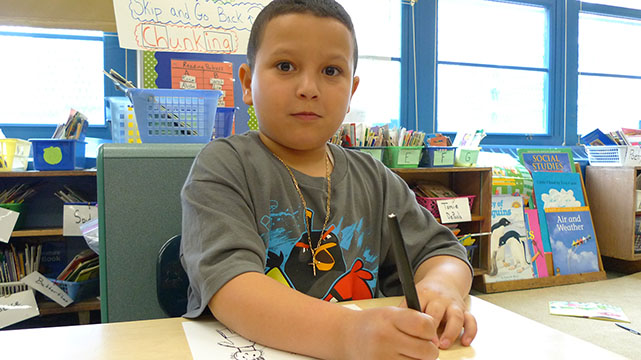This lesson is part of Writing Our Way Through: clear, fun, and engaging “lessons” for writing at home with young people.
Author/Teaching Artist: Frank Ingrasciotta
Age Range: 2nd Grade to Adult
Materials: Paper/ Pencil/ Pens/ Coloring Pencils or Crayons
Overview: This is a fun out-of-the-box exercise in which we visualize and describe the letters of the alphabet as pictures then write poems that riff on these pictures using the letters of our own names. The lesson works especially well for visual spatial learners and reinforces those skills for other young writers.
The Steps:
1. Start off by passing around and looking at images collected from magazines or printed from online. You can find many images by searching online for alphabet photography or photo letters. The picture book Alphabet City by Stephen T. Johnson is especially good for working with young writers.
2. Invite participants to identify a letter they can find within any picture. For example, a photo of a hanging traffic light might look like the letter “E.” A snake might look like the letter “S.” A ladder might look like the letter “H”. Encourage students to take creative liberties by describing what you see, no matter how far-fetched it may seem.
3. Next, ask participants to explore the letters they’ve discovered by looking at them sideways or upside down to see if they can discover a “picture” within these letters. For example, you can show them how the letter “D” sideways might look like a smile. The letter “A” upside down might look like an ice cream cone. The letter “B” sideways might look like eyeglasses.
I remember when one of my third grader students raised his hand in class to share and said, “the ‘R’ in your name looks like a goldfish.” His teacher dismissed him and told me, “don’t focus on him, he likes to grab attention.” I wanted to give him a chance so I asked him to come up and draw it on the smartboard for the class. He turned the letter on its back and closed the opening. Then he drew a fin on top, an eye, a mouth, and bubbles coming out of its mouth. It looked like a goldfish! The teacher was stunned at how creative his idea was. I realized and mentioned to her that he was a visual-spatial learner. From that moment on, she saw him differently in the classroom.
4. After you’ve finished viewing the picture book or images, invite participants to look around and see if they can find any more letters in the objects around them. For example, a door might be the letter “L” – The shape of a scissor might be the letter “X” or “Y” – A scotch tape dispenser might look like the letter “G”.
5. Once everyone has gained an understanding of the concept, invite them to work with you on a collaborative poem using the letters of your name (or another name of their choosing.)
6. Write the name vertically against the left-hand margin of a piece of paper. Write all the letters large and in uppercase. Leave space between each letter so there is room to draw a picture. Drawing on the explorations they’ve just done, ask the students to tell you what images come to mind when they look at the letters, and how that image relates to the person named. For my name, I would give them these examples:
F – The “F” in my name looks like the American flag representing the county I love.
R – The “R” in my name looks like a basketball hoop, my favorite sport.
A – The “A” in my name looks like the roof of my house. I am so grateful for the shelter
it gives me.
N – The “N” in my name, turned sideways, is Harry Potter’s scar. One my favorite books
to read.
K – The “K” in my name is the head of an arrow hitting a target. It’s how I feel when I
get something right.
If you are working with older populations have them create a picture from a letter that connects to something that is personal to them.
If you are working with younger groups you can make it simple and just have the students identify a picture from a letter. You might also share with them Ron Padgett’s poem “The Giraffe,” as an example.
The Giraffe
by Ron PadgettThe 2 f’s
in giraffe
are like
2 giraffes
running through
the word giraffe
The 2 f’s
run through giraffe
like 2 giraffes.
from Collected Poems (Coffee House Press, 2013)
Copyright © 2013 by Ron Padgett.
7. Another approach is to link the exercise to a curriculum component. If you know that your participants are studying a particular subject, let them know they can write about this, if they choose. If they are learning about George Washington, for instance, they can write GEORGE’s name in capital letters and identify objects or events associated with him. Example:
G – The ‘G’ is the diagram map George created to cross the Delaware River for his
counter attack against the Hessians.
E – The ‘E’ is the stall where George would rest his horse.
O – The ‘O’ is one of the curls in George’s hair.
You get the idea. If they are stuck on coming up with an idea for a letter, ask them to
skip it, move on to the next one, and go back to it. They can also work in pairs or groups.
8. Now ask the students to spell out their own names (or a name of their choosing) down the margin of their papers and write their own name picture poems. When they are done writing, invite them to use the colored pencils or markers to draw a picture illustrating how they see the letter.
9. Check in after ten or fifteen minutes. If participants are still writing or drawing, give them some more time to finish up. When everyone is done, invite participants to share what they’ve written and/or show their artwork.

Literary Terms, Forms, and Devices: List poems, Visual Spatial Learning
Acknowledgments / References: Poetry Everywhere by Jack Collom and Sheryl Noethe
(Name Letter Stories)
Mentor Texts: Alphabet City by Stephen T. Johnson
“The Giraffe” by Ron Padgett
Student Poem:

Frank Ingrasciotta is an actor, playwright, stage director, and teaching artist who has served on the Teachers & Writers Collaborative roster for over 20 years. He has facilitated workshops in creative writing and theater arts with students of all ages. Frank is also the writer and performer of the critically-acclaimed Off-Broadway, one-man play Blood Type: RAGU, portraying over 20 characters based on his experiences growing up as a first-generation child of immigrant parents. The show was awarded two United Solo Awards for Best Comic Actor and Best Comedic Script and is presently touring nationally and internationally. He is also the recipient of the Arts Award for outstanding Performing Artist and Arts Educator for Westchester County. As an actor, he has appeared in numerous stage productions regionally and Off Broadway as well as recurring television roles on The Equalizer, The Guiding Light, and One Life to Live. He can also be seen in the SAG short films Figs for Italo and Brooklyn in July on Amazon Prime. Frank has directed many stage musicals, plays, concerts, cabarets, and has also written, directed, and produced the New York Cable Follies, a musical satire of the year’s events in the cable industry, performed for TV network executives from Time Warner, Disney Channel, and HBO. For more information about Frank, log on to his websites a www.frankactordirector.com and www.bloodtyperagu.com


